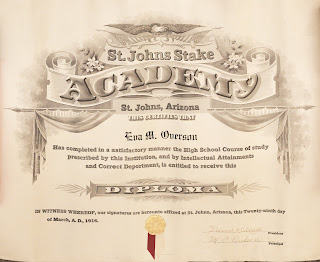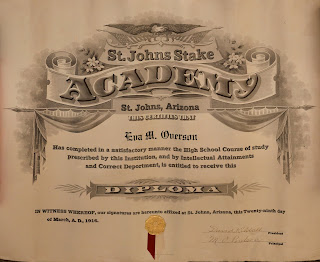

OK folks, this gets pretty technical, but by using this method, you can digitize large documents with very high resolution. The Diploma above has some very small printed detail and is 16 x 21 inches. If you click on either image you can get an idea of the quality of the image, although you cannot see all of the detail available without zooming in. The first image is edited in Adobe Photoshop to correct the color. The second image is the original except for cropping.
The full image is actually a composite of twelve individual images taken with a 135mm lens from about two feet away. The camera has a 15.1 Megapixel sensor and the picture was taken without a flash. Because the original document had been rolled when stored, the image has some variations due to the curvature and creases of the original document. It is a little more difficult, but you can also try copying the document a piece at a time on a flatbed scanner. However, some documents do not lend themselves to the flatbed scanner method.
The twelve individual images look similar to this image:

I had to use a couple of heavy books to hold down the edges of the Diploma because of the document curl, and I cropped out the books in the final image. I am sure if I spent more time, I could come up with a more efficient way of holding the image flat, but I did not have a piece of non-reflective glass handy. I used the photomerge function in Photoshop to stitch the twelve individual photos together into one image, however the composite JPEG image was 43.3 MB in size. I also used a program called PTgui Pro, from PTgui.com, to make a second composite which was only about 12 MB and is the image above. Photoshop CS4 is a pretty expensive program, the complete program is on the Web for over $300 but most copies sold are in the $400 plus range. PTgui Pro is over $200 depending on the exchange rate of the day (it is sold in Euros).
The point here is that often I find documents that are too big to be conveniently scanned. If I use my digital camera to make a single image I am limited by the resolution of the camera. However, if I take multiple shots of the document, using the maximum resolution of the camera, the resulting image, a panorama of the document, has a much, much higher resolution than any one shot. Historically, the challenge has been to merge the individual photos into one large image of the entire document. Now, with the advent of software tools like Photoshop CS4 and PTgui, I can use the software to make a composite of the image and gain the advantage of having a tremendously more detailed image. The detail, of course, does not come without a price. The images are huge as evidenced by the merged Photoshop document before saving as a JPEG. The original Photoshop PSD image came in at 87.6 MB.
It helps to have a flat surface to put the documents on, but a table or the floor both work well. You should also have the camera at as close to 90 degrees to the document as possible. A copy stand would help, but is not necessary. Most of the newer digital cameras have sensors with more than 10 Megapixels and will all work very well. But the better camera and lens system you can afford, the better quality images you will be able to produce. If you are going to try to work with very large images, you will probably learn rather quickly why I use a dual quad core iMac for editing my images.
When taking the images, each individual image must overlap the adjacent images by at least 25% so that the software will be able to match up the pieces. If you try this technique with three dimensional objects, you will get into the issue of parallax problems, that is a shift in the three dimensional image due to a shift in the camera position. For example, hold your thumb out about two feet away from your eyes and then try closing first one eye and then the other. Watch the background shift from side to side. This is the parallax shift and it becomes very difficult to deal with in trying to take panoramic pictures of landscapes and other three dimensional objects.
There are ways to avoid the parallax problems, but if you confine you photos to flat documents and maintain the same exposure values, lens focus and camera distance from the document, there will not likely be any issues. If you are interested in some of the challenges with landscapes and other 3D images, you may want to start by looking at a Website called 360Cities.net.
I will probably talk about this subject again in the future. If you have any questions, please leave comments.




I've also used software by ACDsee to knit several scanned images together. The software allows you to make panamoric views out of several photographs, or to take several hi-res scans and "paste" them together. It is simple to do with such software.
ReplyDeleteTwo more affordable options for photo merging:
ReplyDelete(1) Photoshop Elements is only about $100-$150 and does also include the Photoshop Merge function.
(2) Microsoft has developed a free utility that does only this, and it is the one that I use. It appears to be more powerful than the PS utility, but does not offer the ability to manually move the images to make them fit as PS does. It is available at http://research.microsoft.com/ivm/ice.html